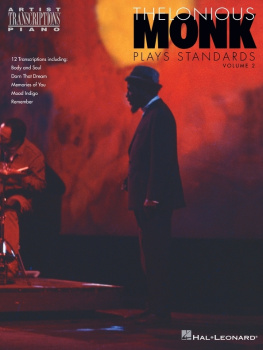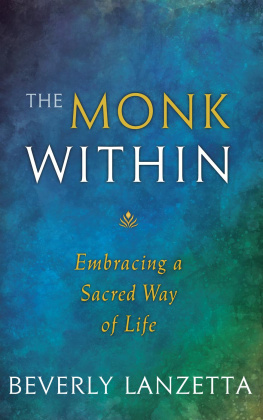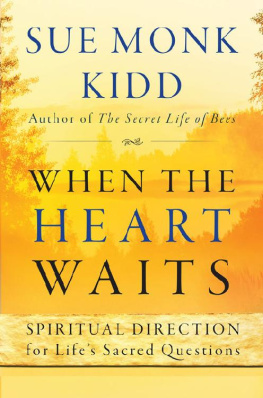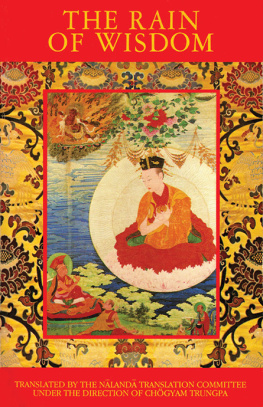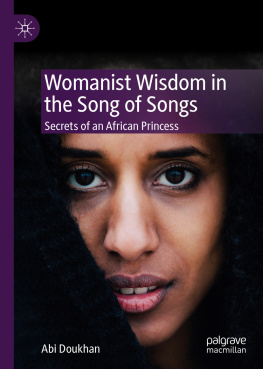Priest-Monk Silouan - Wisdom Songs
Here you can read online Priest-Monk Silouan - Wisdom Songs full text of the book (entire story) in english for free. Download pdf and epub, get meaning, cover and reviews about this ebook. year: 2011, publisher: Sophia Institute Press, genre: Religion. Description of the work, (preface) as well as reviews are available. Best literature library LitArk.com created for fans of good reading and offers a wide selection of genres:
Romance novel
Science fiction
Adventure
Detective
Science
History
Home and family
Prose
Art
Politics
Computer
Non-fiction
Religion
Business
Children
Humor
Choose a favorite category and find really read worthwhile books. Enjoy immersion in the world of imagination, feel the emotions of the characters or learn something new for yourself, make an fascinating discovery.
- Book:Wisdom Songs
- Author:
- Publisher:Sophia Institute Press
- Genre:
- Year:2011
- Rating:3 / 5
- Favourites:Add to favourites
- Your mark:
- 60
- 1
- 2
- 3
- 4
- 5
Wisdom Songs: summary, description and annotation
We offer to read an annotation, description, summary or preface (depends on what the author of the book "Wisdom Songs" wrote himself). If you haven't found the necessary information about the book — write in the comments, we will try to find it.
Wisdom Songs — read online for free the complete book (whole text) full work
Below is the text of the book, divided by pages. System saving the place of the last page read, allows you to conveniently read the book "Wisdom Songs" online for free, without having to search again every time where you left off. Put a bookmark, and you can go to the page where you finished reading at any time.
Font size:
Interval:
Bookmark:
Wisdom
Songs
A Book of Wisdom Chapters
in Five Centuries
Priest-Monk Silouan
Copyright 2011 Priest-Monk Silouan
ISBN: 978-0-9835867-1-5
The right of Priest-Monk Silouan to be identified as the author of this book has been asserted by him in accordance with the Copyright, Designs and Patents Act 1988.
All rights reserved. No part of this book may be reproduced, stored in a retrieval system or transmitted in any form or by any means, electronic, mechanical, photocopying, recording, or otherwise, without written permission of the publisher.
First published by the Sophia Institute in 2011 using their imprint:
Theotokos Press,
The Sophia Institute,
Suite 416, 3041 Broadway,
New York. NY 10027
Tel. 212-280-1592
Available from the printer, Lulu.com.
www.lulu.com
And from the Monastery of St Antony and St Cuthbert,
Gatten, Pontesbury, Shropshire, SY5 0SJ UK.
Website: www.orthodoxmonastery.co.uk
Email: silouan@orthodoxmonastery.co.uk
Telephone: 44 (0) 1588 650571.
The icon of Holy Wisdom on the front cover is the work of the iconographer, Elaine Waller.
The photographer is Leo Lazic.
CONTENTS
Foreword
Very Revd. Dr. John A McGuckin
It is with great pleasure that I write this brief prefatory Foreword to the Reverend Hieromonk Silouans Wisdom Songs . I have seen them in early stages developing, accumulating, standing up together, like a wave gathering shape and energy as it moves onwards, and in this present textual form they will have a larger life and ministry for spiritual seekers who thirst for words of wisdom from springs of authentic Christianity.
When the ancients visited the desert hermits and Startsi in early Christian Egypt, Palestine, and Syria, they habitually gave them the customary salutation: Abba give me a word. It was the correct way to address an Elder, recognizing their spiritual charism to know what the appropriate word was. And what does an appropriate word mean in this circumstance? In the ancient texts both writer and reader shared a common understanding of what that was something which we moderns have often forgotten. It meant a word of the sacred revelation (scripture yes; but not merely a scriptural quotation); a word of sacred power that was subject-specific. In other words, the ancient desert pilgrims asked their Elders for a word that would pierce to their own heart: reveal to them their spiritual condition, and aid them in their healing. The ancients, more honestly than we moderns, perhaps, knew that their spiritual condition was generally one of malaise. They were invalids seeking after healing. Today we have mistakenly approached sin and spiritual disorder in terms of wrong actions; when we ought to have understood them more as symptoms of an underlying sickness. When Jesus forgave, he first laid hands in order to heal. The ancients knew when they had received healing: they felt better; they acted better; their range and scope was restored and increased. Spirituality in this environment, then, did not mean something cozy and comforting: but something that restored life and energy to the debilitated.
The role of the Elder was to seek into the soul; to see through the surface to the deeper heart. So, when the Elders gave their word: they chose that scripture (or perhaps it was an aphorism they concocted from combining scripture and parabolic stories) which was specific to the needs of that person coming before them that day. The Elder might say as a greeting to one pilgrim: The Lord lift the light of his countenance upon you (Ps. 4.6); while to another, who needed to hear something else, he might well say: The Lord is your rock and fortress, you shall never be shaken (Ps. 62.6). As an acerbic, an astringent, he might even say ( like a physician administering bitter medicine for the sake of purgation): Why do doubts arise in your hearts? Trust in God. (c.f. Jn. 14.27). What was common in all of this spiritual teaching was that the ancients felt that the words were alive. It was not like reading the scripture as an old dead book. Here in the way the Elder delivered the word for their need; the scripture acted as a two edged sword, penetrating the innards in a way that laid bare the soul before God (Heb. 4.12).
The Elders function was to serve as priest of the Sacrament of the Word. This is how the word became alive in Christ, and acted as a healing agent in the path of the pilgrim towards God. In that process the pilgrim recognized not only the power of the Spirit of Christ in the sacred word, but also knew the Elder to be a true servant of God. Such is the dynamic that operates throughout all the Desert literature of the ancient monks. It has become an important part of the wider Orthodox Spiritual Tradition, and continues as such even to this day. Father (or Mother) give me a word, is still heard when pilgrims go out to monastic cells to look for guidance and direction in the paths of spiritual life.
The Desert literature grew apace in the 4th century of the Christian Era, and reached a zenith in the 6th century; paradoxically becoming most popular in the great cities such as Constantinople (the Lausiac History was written for a great aristocrat there named Palladius) or Rome, and Milan (Augustine heard how two state assassins had been converted by reading Athanasius Life of Antony and it stimulated his own famous conversion account in the Confessions ) and throughout the great regions of Syria (Theodorets History of the Syrian Monks ). But as this literature waxed and spread in the 5th to 6th centuries, there was a growing sense that the Golden Age was coming to an end. Indeed the early centres such as Skete and Kellia were devastated by barbarian invaders and never really recovered after the 6th century. The Desert literature was in part packaged in a design to spread it internationally in the very moment its actuality (in the desert monastic communities) was coming under threat of survival. So it was that the tradition of the cave hermits, and extreme solitaries, passed into coenobitic (common life) monasteries of the Christian world. St. John Klimakos, an extreme hermit over many decades in the Sinai desert, was asked, at the end of his life, to enter St. Catherines Sinai, as its Higumen (Abbot) and he too composed his famous 7th century book of aphorisms The Ladder of Divine Ascent as a manual of instruction to monastic seekers, at a time he sensed was the End of the Golden Age for desert asceticism. With books such as these the Desert Literature began a new, a second life, as a formal archetype for much later ascetical writing.
What Early Christian tradition now had was a cluster of coenobitic monasteries in the Byzantine tradition, spreading a common tradition from Constantinople to Rome and Ethiopia, to Edessa and Russia, all sharing a common spiritual and liturgical culture, which increasingly made a literary synthesis in its spiritual writing between three kinds of texts that devolved from the earlier ages of the Church. These three types were what could (roughly) be designated as:
First, biblical and theological commentary (what we might today call patristic writing, and which progressively left behind the great early controversies (such as the Nicene and Chalcedonian disputes) to become less controversial and more interior in character. One can see this transition in the movement of patristics from Sts. Athanasius of Alexandria to Gregory the Theologian, or from Basil the Great to Maximus the Confessor. Even when the likes of Sts. Gregory and Maximos are still being controversialists, their writing is clearly much more attuned to deeper inner realities; they sense their readership is going to be one of many centuries ahead of them, not merely the apologists of their day.
Secondly: we see developing in the collected literature great philosophical and sophianic interests (materials dealing with aporetic and difficult theoretical issues in the spiritual life). Much of the Desert Literature had quickly devolved into parables of how the ancient Egyptian Elders behaved and performed miracles (Tales of the Desert as much as Sayings of the Fathers). This type of literature exemplified a highly practical character a moral exemplarist nature. But the literature also extended its range with writers such as Evagrius (surviving in the text tradition as St. Nilus of Sinai) and the later Byzantine writers, who started to produce books of Apophthegms of an advanced nature, addressed to seriously attentive seekers after spiritual wisdom. These were often called Kephalaia (a word that simply means Chapters) or Centuries (evidently made up of collections of aphorisms set together in a catena (chain) of a 100 or groups of 100 at a time). These books tend to be less interested in a simple moral end result, and more in pushing the limits of the readers intelligence and level of understanding. They share an ancient character of writing known as aporia. This derived from the environment of the ancient schools which expected the learning environment to pose the question and force the listener actively to produce an answer from his or her range of experience. In the spiritual domain, the aporia posed a challenge of spiritual understanding to the reader/hearer, and asked for a response. Such literature was amplified and assisted by the presence of the spiritual master to their children, usually a group of immediate disciples in the monastery, or a wider circle of spiritual disciples who would meet with the Elder regularly and confess their hearts to him. In this way the Elder could watch over the development of a group of disciples, and resolve the aporetic issues as they arose in common. The books of Kephalaia or Centuries were a common genre of the day and lasted through to the late medieval Byzantine environment. One of the great patristic writers of this genre was St. Maximus the Confessor, others (less well known perhaps) were Sts. Symeon the New Theologian and his disciple Niketas Stethatos in the 11th century, Elias the Ekdikos, St. Gregory of Sinai and many hesychasts.
Font size:
Interval:
Bookmark:
Similar books «Wisdom Songs»
Look at similar books to Wisdom Songs. We have selected literature similar in name and meaning in the hope of providing readers with more options to find new, interesting, not yet read works.
Discussion, reviews of the book Wisdom Songs and just readers' own opinions. Leave your comments, write what you think about the work, its meaning or the main characters. Specify what exactly you liked and what you didn't like, and why you think so.



